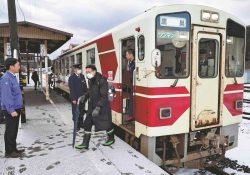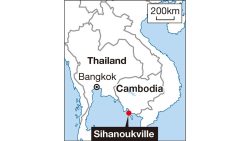
Elizabeth Groginsky, New Mexico’s secretary for early childhood education, views a new playground in Roswell in May.
17:32 JST, November 7, 2022
The trip from Santa Fe to Roswell was lined with sand and alien replicas, and when Elizabeth Groginsky arrived late morning, she found child-care workers with purple balloons.
She pulled off the dusty highway and into a church parking lot, flanked by brown, desolate yards. The balloons almost seemed hopeful in those environs, and as Groginsky stepped out, she did, too.
She’d been overseeing New Mexico’s early-learning programs for two years, a time when centers closed, parents went months without pay, and 111,000 people left the industry nationwide. And yet what Groginsky had done in that time had turned her into something of a child-care star. While other states used federal relief dollars to keep their child-care industries afloat through the pandemic, Groginsky and New Mexico’s governor used the state’s $436 million share to help transform theirs. They built centers, significantly increased the amount the state pays providers and made child care free for most families.
Those were important wins, Groginsky thought, though the federal relief money is temporary. State legislators had yet to commit as much as Groginsky believed she needed to truly fix her industry, but voters could approve a new, permanent pot of funding in the fall midterm elections. And so, this spring, she drove across New Mexico to talk to providers about the work ahead.
In Roswell, she made her way past the balloons and into the fellowship hall, where the child-care workers had adorned a stage with more balloons. Nearly everyone in the crowd of 50 cheered. Groginsky spoke for 15 minutes, then asked whether anyone had questions. The first four at the microphone simply thanked her. A woman in her 60s announced she’d used a scholarship from Groginsky’s department to go back to school, and the director of a local center said parents had called her sobbing with relief. States had never invested enough in child care.
“But why shouldn’t New Mexico be the first to do it?” Groginsky asked the group.
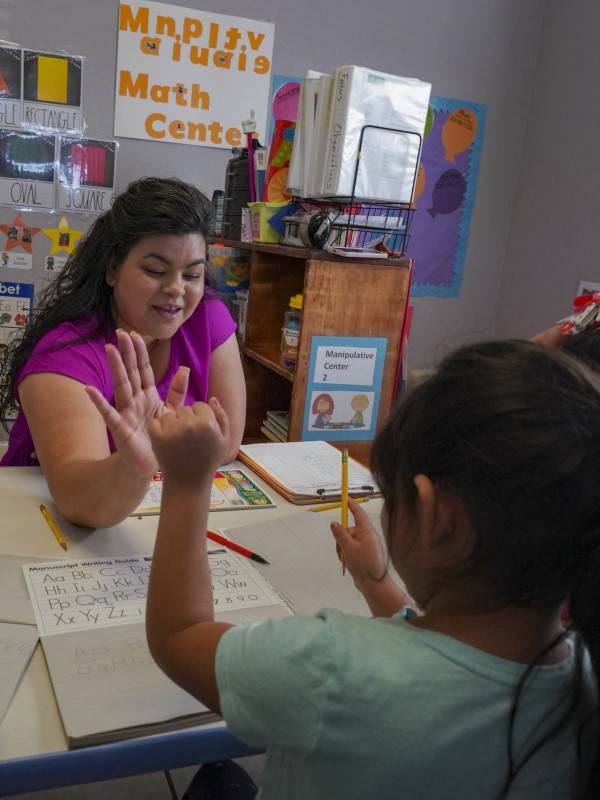
Juanita Segovia congratulates a student during writing practice at Carousel Learning Center in Dexter, N.M.
The crowd roared, then fell quiet. Eventually, a woman named Juanita Segovia stood and broke the silence. She owned a center in nearby Dexter, and she told Groginsky she was grateful for the pandemic money but didn’t feel confident planning her budget around it. The last of New Mexico’s millions are set to expire by 2024. Parents can’t afford to pay the increased fees the state has been subsidizing, and Congress isn’t giving additional relief.
“Right now, with the help you guys are giving us, you have given us assurance for one year,” Segovia said. “But I’m afraid to pick up their salary, then what if it doesn’t go through for the following year? I won’t be able to keep up that same rate. And if I take away that payment, they will leave me.”
Groginsky had traveled down, in part, because of this very problem. New Mexico had sent out millions of dollars, but most day cares had not raised their teachers’ salaries. Many still earned minimum wage. At the start of 2020, 61 percent of the state’s child-care centers didn’t have enough teachers, and the pandemic had made that worse. Groginsky worried that if they didn’t boost salaries, others would abandon the industry, too. The state wouldn’t have enough teachers to educate its youngest learners, and Groginsky’s other wins might not matter.
Segovia sat, and Groginsky told her she understood. She once ran six Head Start locations outside Denver, and she knew how slight the profit margins can be. Without assistance, one wage increase could bankrupt some centers.
“I’ve heard this from a few people,” Groginsky said. “You’re a strong, smart businesswoman. You’re looking at this, saying, ‘What am I going to do? I don’t want to lose staff.’ “
Yes, Groginsky allowed, the federal dollars won’t always be available. But the way to secure stable funding, she believed, was to show policymakers she had made good on the millions they’d already invested. To do that, Groginsky had to persuade child-care workers like Segovia – historically among the nation’s lowest-paid laborers – to spend more than parents will ever be able to afford to pay them.
“I think,” Groginsky said, “we’re all going to have to take some risks.”
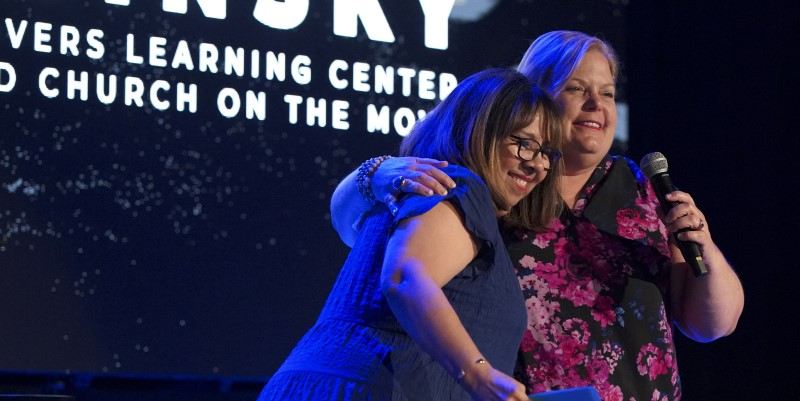
Elizabeth Groginsky, right, hugs principal Sally Green during a Roswell, N.M., gathering of early childhood educators in May.
***
These days, advocates tend to agree that New Mexico is leading the nation when it comes to child care, but few predicted its sudden success. The state is one of the country’s poorest, and its educational outcomes are so bad, the Annie E. Casey Foundation has ranked it among the worst for child well-being every year for the past two decades.
Things started to change when Groginsky arrived.
Before 2019, the state spread its early-childhood programs across three departments. That’s not unusual: Some states funnel their child-care programs into as many as six agencies. But when Michelle Lujan Grisham became governor that year, she pulled the programs together, and she created a Cabinet-level position to oversee them. The new Early Childhood Education and Care Department made it easier for day cares and home-visiting programs to work together, and it conferred a new gravitas on an industry some had seen as little more than babysitting. When Groginsky became the department’s secretary, the state Senate had to confirm her.
Lujan Grisham, a Democrat, had high hopes for the new department. Soon after she created it, she announced that it would be the vehicle “to arguably the most important turnaround we must and will make as a state in the coming years.” She chose Groginsky to lead it, in part, because Groginsky had more than 20 years of experience in the early-childhood field. She had made her way up from those Head Start classes in Denver to second-in-command over D.C.’s early-learning programs.
At the time, D.C. had done far more to improve its day cares than the rest of the country had, and while Groginsky was there, she helped shepherd a nation-leading initiative to require workers to earn associate’s degrees in early-childhood education. Groginsky and others argued that the new requirement would boost early learning and close the achievement gap between children from poor and middle-class families, but it proved controversial. Workers protested outside the mayor’s office for weeks, and a group eventually filed suit. (The U.S. Court of Appeals for the D.C. Circuit upheld the requirement in August.)
Groginsky believes the requirement was fair and needed, but she learned to roll out new regulations carefully. When she left D.C. for New Mexico in late 2019, she decided she would spend the bulk of her first year in the Southwest listening to providers and families.
But a few months after she arrived, the pandemic hit. Day cares shut down, and the industry saw a 10 percent decline in the workforce. Child-care workers have long been underpaid and undervalued, but many came to understand their plight for the first time during the pandemic. The country’s economy depends on child care, but its workers, nearly all of whom are women, earn an average of $27,680 – less than bellhops and taxi drivers – and few earn benefits or sick time. Suddenly, politicians began mentioning the industry in stump speeches, and Congress agreed to send states a total of $50 billion – far more than it had ever invested in early learning.
Groginsky barely had a staff in place when the coronavirus made its way to New Mexico. But hospital workers needed child care, and day cares without clients needed revenue, so she spent her first few months mitigating disaster.
Still, Groginsky understood early on that patching holes would not be enough. If she wanted to make the dramatic changes the industry had long needed, she had to do it while people were paying attention.
By late May 2022, when Groginsky visited Roswell, she and the governor had rolled out so many new initiatives, Groginsky ran out of breath as she listed them from the stage. Those programs seemed to have worked. Parents had returned with more kids than ever, and centers were operating five days a week. But providers across the state said they didn’t have enough staff to watch all the kids who needed care, and Groginsky hoped a listening tour might help her figure out the best way to bring workers back.
Roswell was one of 26 communities Groginsky planned to visit, and after the church listening session ended, she toured two local child-care facilities to see how they had spent their share of the pandemic relief. The state had given child-care centers an average of $282,500 each, and Groginsky had found that providers used the money in a range of ways. A director in the town Truth or Consequences had increased wages and added retirement and health-insurance plans. Others had installed security systems or paid off their mortgages.
The church had opened a day care during the pandemic, so after Groginsky finished answering questions, she headed across the street to check it out. She asked a few questions, and her voice pitched up when she spoke to babies, but mostly she nodded as the day-care director led her outside to show how she had spent the money.
“So,” the director said, waving toward a colorful, plastic structure with two slides on AstroTurf. “This is our playground for 1- and 2-year-olds.”
Groginsky had seen several new playgrounds on her tour of the state. She wasn’t opposed to the expense – providers had learned during the pandemic that they needed more and better educational outdoor space – but playgrounds wouldn’t fundamentally change the industry. The church day-care director said she had given out “really good” Christmas bonuses, and she had bought new changing tables, but when Groginsky asked about benefits, the director said her employees didn’t have health insurance, and their salaries hadn’t gone up.
***
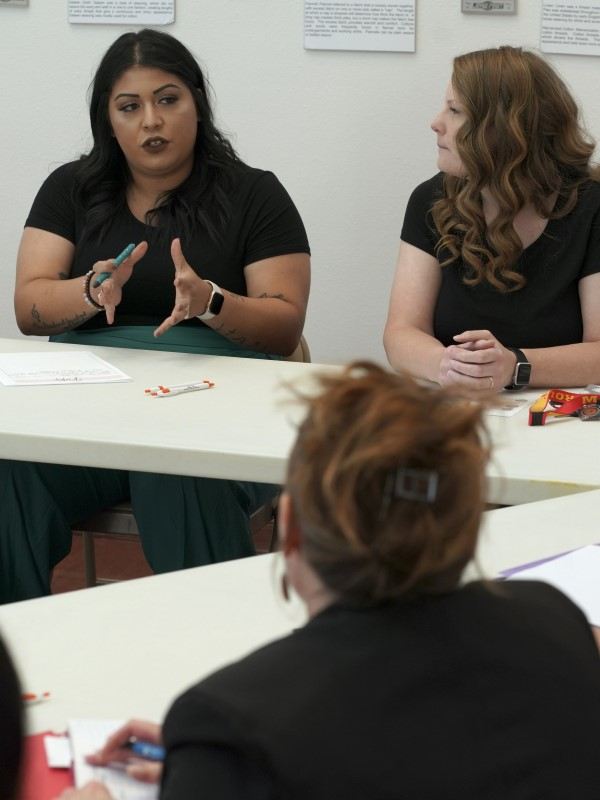
Educators participate in a discussion with Groginsky in Artesia, N.M.
The next morning, Groginksy and her staff drove 40 minutes south to Artesia, a small community whose downtown looks out on the Navajo Refinery. Groginsky’s Roswell appearance had made the local newspaper’s front page, and a dozen or so people were waiting at Artesia’s historical museum to meet her.
A few hours earlier, Groginsky’s office had announced it would give out $10 million to build new day cares, and one woman had driven in from Roswell to ask for application advice.
The day was temperate, and covid cases were ticking up, so Groginsky left the door open as she started her second listening session. Oil was booming in Artesia, and the smell of it wafted in.
“A couple of big announcements,” she said. “The governor has made child care free for most New Mexicans. Families of four who earn up to $111,000 will have their child care paid for.”
That would help parents, Groginsky said, but the new initiative would also give more money to day cares. Essentially, Groginsky explained, what the governor had done was expand eligibility for a federally funded program that subsidizes care for low-income families. An additional 2,183 children had joined the program. That was good news for providers, Groginsky said, because the state had recently made an extraordinary change to its subsidy program.
Before the pandemic, New Mexico did what other states do: Every few years, state leaders asked providers how much they charged families. Then, the state set its subsidy payments somewhere within the range of what parents could afford.
During the pandemic, Groginsky’s department decided to survey child-care workers to learn how much providing care actually costs. Groginsky quickly found that some day cares weren’t even breaking even. They were losing money every year. If Groginsky wanted child-care centers to pay workers at least $12 an hour, her team found, the state needed to significantly boost its monthly payout.
The state was now paying “a little over a thousand dollars a month” per child, she told the museum group.
A few of the providers looked up from their notes. That dwarfed the amount most families could afford. In some towns, day cares could charge families only $425 a month to watch an infant.
Siobhan Coffelt, a woman who ran a highly rated day care called Little Castle, raised her hand. “We’re at $680,” she said.
“That’s $350 more per baby that you’ll get each month for those families who are eligible,” Groginsky said. “You can just see the revenues.”
A few providers nodded in approval. Under the new rates, a center with eight to 10 babies would earn an additional $3,000 every month. And Groginsky planned to do more in the future. She knew $12 an hour wasn’t enough, so she and her staff hoped to increase the subsidy so that providers eventually could pay at least $18 an hour.
“It’s not unique to New Mexico that our country has not funded a prenatal-to-5 system,” Groginsky said. “It has been historically underfunded, and that resulted in low wages, predominantly for women of color who have been doing this work and have not had their work valued. And it’s gone on so long, and this state and this governor have said, ‘No more.’ The governor ultimately wants [child care] to be free for everybody, everywhere, permanently. Right now, we’re using the federal relief dollars to make that happen through June of 2023.”
Coffelt raised her hand again.
“Everything you are doing is great,” she said. But, like the teachers in Roswell, Coffelt didn’t want to increase salaries one year, only to have to bring them back down when the relief dollars ran out. Plus, she explained, the subsidy changes wouldn’t dramatically affect Little Castle’s fortunes because only a quarter of her clients qualified for them. Most of the parents who needed Coffelt’s services worked in the oil fields, and the average wage there was $123,000 – too much for the subsidy. Little Castle’s revenue would stay roughly the same.
Groginsky told Coffelt she knew of at least one solution that might help providers who didn’t benefit from the subsidy expansion. The oil boom that lifted wages in Artesia might actually provide long-term, stable funding.
In 2020, a month before the pandemic, state lawmakers invested $300 million of oil revenues into an Early Childhood Education and Care Fund. They had agreed to give day cares a small portion of that each year, but as the price of oil skyrocketed, so had the trust. Economists now expected it to be worth $4.3 billion by 2025.
On Election Day, voters will decide whether to approve a constitutional amendment that would allow Groginsky’s department to use some of the revenue from the state’s Land Grant Permanent Fund, a century-old reserve also backed by oil and gas revenues.
Lawmakers have not decided whether their oil windfall means they should send more to child care. One long-term senator has said child care is “way overfunded” in New Mexico, and Mark Ronchetti, the Republican candidate for governor, opposes the constitutional amendment.
“I think some get it, but a lot of people don’t,” Groginsky told the Artesia providers. “That’s where we all need to do a better job educating our communities and our legislators about the value and the importance of child care. It is an incredible opportunity for children to be in those safe, nurturing, healthy environments, which we know does so much for their brain development and their relationships and their attachments with others.”
As she toured the state, Groginsky often talked about child care as something far more important than a daytime babysitter. If New Mexico is going to turn its statistics around, she said, its children need to begin receiving a quality education soon after they’re born. That means they need to be in small classrooms with highly qualified teachers.
The problem was that teachers had more lucrative options. Some of Coffelt’s staff earned $12.50 an hour, the local Pizza Hut paid delivery drivers closer to $18, and women with degrees could work in the local school system. There, they’d start at $50,000 a year.
“I mean,” Coffelt said, “you’re talking about a $30,000-a-year difference.”
The Land Grant fund is partly responsible for that wage discrepancy. The state already uses the fund to pay for its K-12 system, and that public investment allows schools to pay teachers far more than child-care workers earn. No state has ever invested in day cares the way it has public schools, but New Mexican voters could begin to change that by approving the constitutional amendment.
Later, over a catfish lunch at a local steakhouse, Groginsky told her staff that she was dismayed to hear Coffelt paid some of her staff just slightly more than minimum wage. The state had sent Little Castle $484,150 in pandemic relief.
“I saw in their write-up, they’ve done a lot with bonuses, but long term, you’re going to lose people,” Groginsky said with a sigh. “If we wake up in a year or two, and hundreds of millions of dollars have gone into the industry, and the salaries are still minimum wage, that will be of great concern.”

An oil refinery dominates the skyline in Artesia, N.M.
***
Groginsky spent the rest of the week in Carlsbad, then a few days traveling outside Albuquerque. She and her team wrapped up their tour with a three-day trip close to the Texas border.
Everywhere she went, people thanked her for the money. Her department had awarded nearly 3,000 scholarships to child-care workers who wanted to return to school. And the state had used $197,000 of pandemic relief to save Grant County’s only extended-hours child-care center, a move that meant more than 60 children did not lose care.
Still, residents in several cities told Groginsky they couldn’t find anyone to watch their kids. Two towns didn’t have a single child-care center, and others needed workers to fill open positions.
The tour only reaffirmed Groginsky’s belief that one way to bring workers back was to raise wages, and so, in early October, a few months after Groginsky returned to Santa Fe, the governor announced that the early-childhood department would soon give centers money specifically to raise wages to at least $15 an hour. Groginsky called it a “win for all New Mexicans.” Her department would restrict the money so day-care owners couldn’t use it on playgrounds or bonuses, but they’d leave it up to the owners to opt in. If they wanted the grants, they would have to give out raises.
To pay for that increase, the state is using another batch of pandemic dollars. For now, like the rest, it’s only temporary.
"News Services" POPULAR ARTICLE
-

American Playwright Jeremy O. Harris Arrested in Japan on Alleged Drug Smuggling
-

Taiwan President Shows Support for Japan in China Dispute with Sushi Lunch
-

Japan’s Nikkei Stock Average as JGB Yields, Yen Rise on Rate-Hike Bets
-

Japan’s Nikkei Stock Average Licks Wounds after Selloff Sparked by BOJ Hike Bets (UPDATE 1)
-

Japanese Bond Yields Zoom, Stocks Slide as Rate Hike Looms
JN ACCESS RANKING
-

Keidanren Chairman Yoshinobu Tsutsui Visits Kashiwazaki-Kariwa Nuclear Power Plant; Inspects New Emergency Safety System
-

Imports of Rare Earths from China Facing Delays, May Be Caused by Deterioration of Japan-China Relations
-

Japan Exports Rise in October as Slump in U.S. Sales Eases
-

Govt Aims to Expand NISA Program Lineup, Abolish Age Restriction
-

Blanket Eel Trade Restrictions Rejected










